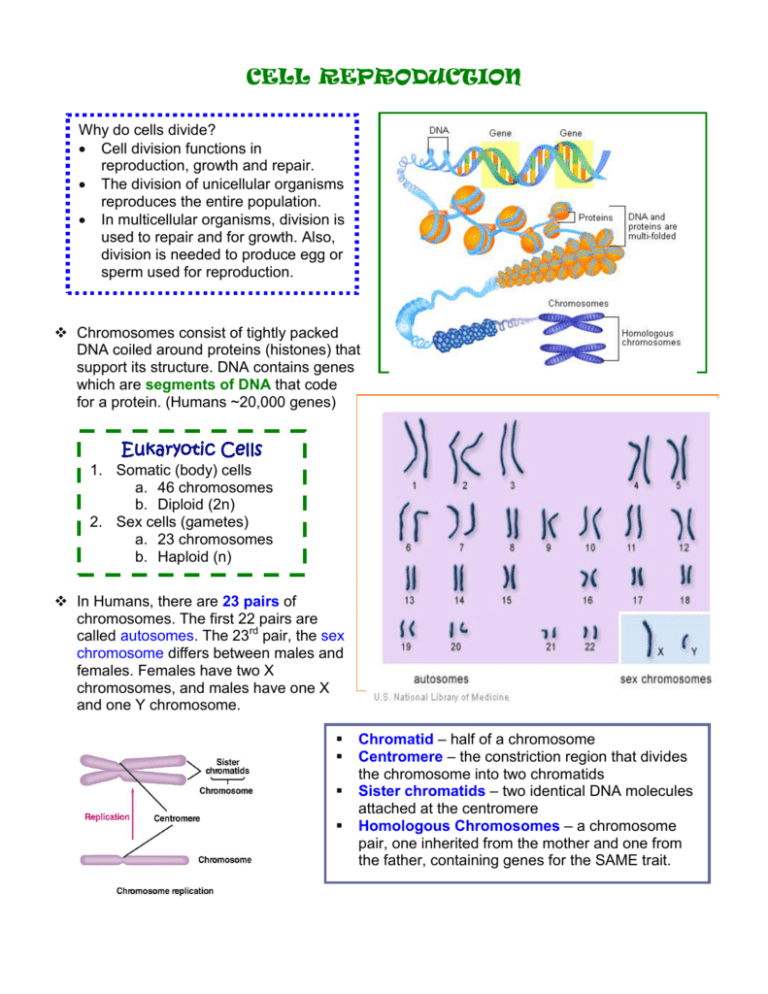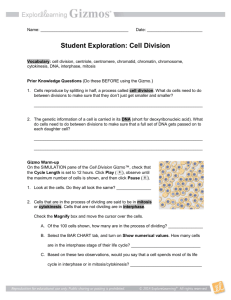CELL REPRODUCTION
advertisement

CELL REPRODUCTION Why do cells divide? Cell division functions in reproduction, growth and repair. The division of unicellular organisms reproduces the entire population. In multicellular organisms, division is used to repair and for growth. Also, division is needed to produce egg or sperm used for reproduction. Chromosomes consist of tightly packed DNA coiled around proteins (histones) that support its structure. DNA contains genes which are segments of DNA that code for a protein. (Humans ~20,000 genes) Eukaryotic Cells 1. Somatic (body) cells a. 46 chromosomes b. Diploid (2n) 2. Sex cells (gametes) a. 23 chromosomes b. Haploid (n) In Humans, there are 23 pairs of chromosomes. The first 22 pairs are called autosomes. The 23rd pair, the sex chromosome differs between males and females. Females have two X chromosomes, and males have one X and one Y chromosome. Chromatid – half of a chromosome Centromere – the constriction region that divides the chromosome into two chromatids Sister chromatids – two identical DNA molecules attached at the centromere Homologous Chromosomes – a chromosome pair, one inherited from the mother and one from the father, containing genes for the SAME trait. CELL CYCLE – series of events of cell growth and division Steps of Cell Cycle – 1. Interphase – G1, S, G2 2. M phase – mitosis or meiosis 3. Cytokinesis Cell Cycle: Creating Somatic Cells – Sometimes the cells exit the cell cycle and enter the G0 phase. In the G0 phase, cells are alive and metabolically active, but do not divide. Many cells in the human body, including those in heart muscle, eyes, and brain are in the G0 phase. If these cells are damaged they cannot be replaced. Some cells can be “called back” from the Go phase to the cell cycle by certain external cues such as growth factors. Interphase, Mitosis, Cytokinesis INTERPHASE – accounts for 90% of cycle 1. G1 (Gap) phase – cell undergoes growth & normal functions 2. S phase – DNA replication 3. G2 (Gap) phase – cell prepares to divide MITOSIS – nucleus divides into 2 identical nuclei with identical genetic information In Eukaryotes --- It is the main process of growth and repair. It is the process by which unicellular and multicellular organisms asexually reproduce. STEPS of MITOSIS --- PROPHASE – chromosomes condense and become visible; centrioles move to opposite sides of cell and form spindle fibers (microtubules); nuclear membrane disappears METAPHASE – spindle fibers attach to centromeres and align chromosomes midway ANAPHASE – spindle fibers move sister chromatids of each chromosome apart to opposite sides of the cell TELOPHASE – chromosomes decondense; nuclear membrane reforms; 2 new nuclei are formed CYTOKINESIS – cytoplasm divides; cell pinches in half to form 2 new cells In plant cells, a cell plate forms to divide the cytoplasm. Yields: 2 diploid daughter cells - genetically identical to parent Cell Cycle: Creating Gametes – Interphase, Meiosis, Cytokinesis INTERPHASE – growth, DNA replication, preparation MEIOSIS – nucleus divides twice into 4 different nuclei with different genetic information In Eukaryotes --- It is the formation of gametes for sexual reproduction. Meiosis I: PMAT 1 o A single cell divides into 2 daughter cells that are not genetically identical. o The homologous chromosomes come together and literally swap parts of themselves with each other. This process is called Crossing Over and ensures that the daughter cells produced after the first cytokinesis will not be genetically identical. o Independent Assortment – each homologous chromosome is randomly assorted at the equator and into different gametes Meiosis II: PMAT 2 o Two cells divide to form four haploid daughter cells. MEIOSIS CYTOKINESIS – division of the cytoplasm Yields: 4 haploid daughter cells – genetically different from parent CYCLE – control mechanisms govern the rate of cell division: Molecular control system - Several checkpoints act as built-in stop signs that halt the cell until they are over-ridden by go ahead signals. Three checkpoints exists in G1, G2, and M. Cells also have a predetermined lifespan. Timing is controlled by regulatory proteins – cyclins and kinases. These proteins selectively access, activate and silence information in DNA. Contact Inhibition – Cells release chemicals to inhibit growth when they become too crowded. When things go wrong? Uncontrolled Cell Growth -- Mutant genes cause tumors to form by disrupting normal cell cycle controls. Altered cells grow and divide abnormally. Tumors may be cancerous. Prokaryotes Cell Division Most bacterial genes are located on a single bacterial chromosome (~4million base pairs) which consists of a circular DNA molecule and associated proteins. Bacteria do not have as many genes or DNA molecules as long as those in eukaryotes (Humans ~2.3 billion base pairs), their circular chromosome is still highly folded and coiled in the cell. Prokaryotes reproduce by binary fission, not mitosis. In binary fission, chromosome replication begins at one point in the circular chromosome, the origin of replication site. Mitosis VS. Meiosis








